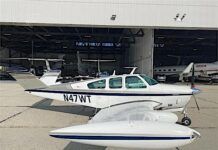Electric air taxi manufacturer Joby Aviation announced completion of its pre-production flight test program and is now shifting its focus to obtaining air certification using its prototype aircraft.
In a press release issued Thursday, Joby noted its two pre-production aircraft collectively conducted more than 1500 flights, covering a distance of more than 33,000 miles, with more than 100 of these flights including a pilot onboard. Joby also highlighted a significant achievement of its second pre-production aircraft, which conducted the first electric air taxi exhibition flights in New York City, flying from the Manhattan Downtown Heliport over the Hudson River in November 2023.
Joby’s Founder and CEO JoeBen Bevirt touted the company’s latest achievement, saying, “Our pre-production aircraft were the second full-scale generation of Joby’s design, and their performance met or exceeded our predictions throughout the program, successfully achieving our targets for maximum range, speed, and a revolutionary acoustic footprint.”
With the pre-production testing phase complete, Joby is now focused on conducting flights with its production prototypes as it prepares for formal flight testing and obtaining full commercial airworthiness certification.
Joby’s electric air taxi is engineered to carry a pilot and four passengers, capable of reaching speeds of 200 mph. The aircraft offers high-speed mobility while reducing noise levels in comparison to helicopters and producing zero emissions.
Joby expects to begin commercial passenger operations in 2025 pending FAA certification.



































What’s this, a company that’s laser focused on making a real, functional, next generation aircraft that’s actually certifiable, instead of only virtue signaling, grant whoring, and trying to scam investors?!?
Even if the market doesn’t adopt the tech, at least they’re taking the correct approach to designing a new aircraft.
Keep up the good work Joby.
One would argue that a correct approach to horse breeding is to euthanize the chronically lame.
wow, 1,500 flights covering 33,000 miles.
So, that works out to an average 22 miles per flight… not a very useful range.
We’ll see how all these e-aircraft work after entering some sort of service.?
Wow, could have been 1499 flights covering 1 mile total and 1 flight covering 32,999. There will, however, be many flights in the mission considerably less than 22 miles in length.
Well JimH, did you ever build an experimental aircraft. If so, how long was your first flight? And, if not, I guess that it is always easier to be an armchair critic.
I would love to be able to be positive about this effort and/or to hear that it happened as they’re claiming BUT … there’s always a “but,” isn’t there.
First off, the thing is going to carry five people at 200mph at altitudes up to 10,000′ … how many GA airplanes can do that much less an eVTOL? This led me to their PressR to see what IT says. OH! … they’ve flown 1,500 flights but only 100 of them are with a pilot aboard. That means 1,400 flights were unmanned. And what happened to the five PAX? How can they claim that if they haven’t done it?
Then, in a July 2021 Pressr, they’re claiming a range of 200 miles but they’ve only flown a pre-prod airplane one time 3 years ago a distance of 154.6 miles in 1+17 with ONE pilot. My $1 calculator says that’s ~124mph. Hmmm … OK … another statement says that in partnership with NASA in 2022, it did demo 200mph. OK .. but was that while pointed at the ground flown remotely or autonomously OR in level flight with five people aboard at 10,000′? See the problem here? In that PressR, they’re claiming a range of 150 miles. OK, so if you’re flying 200mph with a range of 150miles, that’s an endurance of 45 minutes. Subtract the 30 min requirement for reserves and you have an endurance of 15 minutes before it’s illegal. Isn’t that the problem the Pipistrel Velis electro had when PB flew in it and reported to us?
I’m aware that some of my ‘bubbas’ from Edwards AFB have flown the thing … likely because the USAF sees merit in the idea and has shoveled some serious money their way. OK … for special ops … no problemo. That must be how they’re paying for the 800 employees they have all over the place?
Finally, I discovered that at the bottom of their PressR’s, there’s a massive disclaimer called “Forward Looking Statements.” In ALL of my reading about different new aviation ideas, I’ve NEVER seen this done. The very first sentence says, “This press release contains “forward-looking statements” within the meaning of the “safe harbor” provisions of the Private Securities Litigation Reform Act of 1995, including but not limited to …” OH! I see … they’re listed on the NYSE as JOBY — JoeBen shortened, I guess? (cute) — so this is required. I invite the readers to go see for themselves. They have some crafty lawyers, too, I guess?
Well … at least their airplane isn’t computer generated (sic). AND … all the usual buzz words are in their reports … it’s ‘sustainable and efficient.’ I guess they found a tree that grows electrons. Sweet! WAIT! They didn’t say how long it takes to charge one up. MY airplane is sustainable, too. I pull up to the pump and pour in some dead dinosaurs and … in 10 mnutes … whamo … it’s sustainable for four more hours.
I guess they didn’t think someone would pay attention to the details? (You know … where the devil lives). I’m beginning to smell the odor of burning Vaporware here. Maybe with USAF money Icon mighta survived, too? Looks like the folks at Joby are?
It’s getting tough to be positive with stuff like this being reported on … OH! I already said that.
“It’s getting tough to be positive with stuff like this being reported on …“
… and that is it in a nutshell.
“Finally, I discovered that at the bottom of their PressR’s, there’s a massive disclaimer called “Forward Looking Statements.” In ALL of my reading about different new aviation ideas, I’ve NEVER seen this done.”
This statement is often included in statements made my a publicly traded stock now that people can sue if they lose money on a bad investment. I agree though, all of these E-VTOL stocks are a risky bet but this is probably the best of all of them and the farthest along in the long long certification journey.
More specifically, any company offering securities to the public MUST include this statement to ensure that they are not subject to lawsuits for giving guidance to the public about possible future outcomes; otherwise, any failure to attain the forecast could open the company to securities fraud litigation. A company is still not able to use this “safe harbor” to make knowingly false statements.
Larry, is it normal to put 5 passengers in a plane during testing? I think that’s being a bit tough on them, don’t you?
I for one am happy to see their efforts. I wish them luck.
Fair question. Not at first but after all this time AND money, one would think that a demo of it’s ultimate claims would have been accomplished.
Thankfully reporting the “goofy and nutbar” is open to all of us and when the dust settles folks will wonder where their money went and “what went wrong”.
Cynical analysis from people who know nothing about Joby’s test regime and requirements gets tiring.
The company has reported results consistently and honestly since their days of flying tethered in the local quarry. It’s a remarkable aircraft for its intended mission of short hop Uber style trips from small municipal airports to large metropolitan airports for low cost.
You’re confusing my cynicism with reality, NordicDave. I’m a BIG believer in the latter. You know … “where the rubber meets the road.” Lofty claims by a manufacturer have to be followed up by productive results on a reasonable timeline. No amounts of positive thoughts or exaggerated claims will alter what happens when/if Joby meets the real world. Don’t believe me … let’s talk about Icon which had some of the slickest kiosks and dancing girls and loud music at Airventure, et al. They, too, had a nice facility and were led by a guy with an impressive educational resume. Where are THEY now. eV’s don’t seem to be doing so well these days, either … despite a few being bought by possessed greenies.
I agree that Joby is further along than most other similar endeavors … and I said that. But in the end and on top of everything else, their “intended mission” has to make money … not be a sinkhole for still more lost investments. THAT’ll be the true litmus test, won’t it. They said it’d be flying in 2024 … well, half the year is almost up … I’m waiting. Well, maybe John Kerry will have one so he can get to his jet faster and Petey will have one numbered, N 1 1/2? Say … I hear they’re gonna build an electron refueling station at KOSH.
And — oh by the way — I have 27 years involved with flight test … how many do YOU have?
More hysteria from people who like to throw rocks. …ICON and John Kerry have nothing to do with the Jody’s successful publicly scheduled flight program.
It’s enjoyable to watch them test fly the plane routinely from my local field.
OK, Dave … so you enjoy watching Joby “fly the airplane.” Great. So based upon that analysis you have decreed that the airplane will meet its lofty albeit not demonstrated delayed performance claims, will be affordable and find a ready market ergo be a financial success. Also great. Thank you; great analysis.
It’s no wonder all these wonderous companies find a bevy of investors ready to part with their money.
NordicDave, I agree. I do not know if they will be profitable in the long term but if there is no one taking the risk and trying new something new, there is no progress. I own an battery electric car and doubt that I would ever again buy an IC powered car. Same with my battery electric lawn mower and my battery electric chain saw. Hope that I am flying long enough to have a battery electric plane. It is always easier to sit around and be an armchair critic and be negative.
If your lawn is 150 square feet and you drive 20 miles a day you may have made the right choice. My lawn is quite a bit larger and I drive a lot more distance (not going to GREENIE Kumbaya feel good conclaves) so I use what works. My 23 year old chev takes me 600 miles in a day and I can return home whenever I want without making hotel reservations or sleeping in a Walmart parking lot. I only travel when necessary but don’t look forward to having my travel restricted by nutty claims of mileage while sitting in a stuffy jacket or with windows wide open for cooling on hot days. Yes, I do travel by bus occasionally (diesel powered thank you).
I have greater confidence that Joby Aviation will cross the finish line of success. Improvements in “Today’s Battery Technology”, and Powerplant systems being made by suppliers, at a rapid pace, will find their way in all EVTOLs. The Press release, however, states that only pilot(s) were on board the vehicle. Of course performance data will include eventually, data based on projected gross weight, CG, Temperature Ranges, Projected Battery and Powerplant Lives based on normal usage.
Something that seems to be overlooked in the conversation is: Where will all of the Air Taxi pilots come from? There is a commercial pilot shortage now. Will they need multi-engine ATP ratings or will the FAA make “accommodations” for these new aircraft types?
Maybe the pilots will be like Jockeys. Chosen for skills and low weight.
I’m too old, so won’t see it, but I hope that battery technology eventually improves to a point where its energy density approaches that of gasoline or kerosene. When – if – that day comes, there will be little reason to burn petrochemicals to get from here to there.
Considering the huge difference between the energy densities, I don’t think the two will ever be close. I think that in situ power generation (e.g., fuel cells) has far more potential.